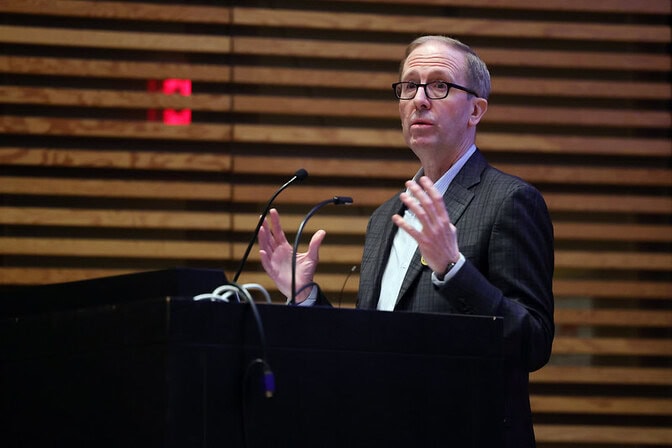
Nuclear energy’s unprecedented growth: A Q&A with Todd Allen
As the U.S. sets a goal to quadruple capacity by 2050, a longtime leader in the field discusses U-M’s role in its future—and past.

As the U.S. sets a goal to quadruple capacity by 2050, a longtime leader in the field discusses U-M’s role in its future—and past.
Experts

Glenn F. and Gladys H. Knoll Department Chair of Nuclear Engineering and Radiological Sciences
Nuclear energy is in the midst of its largest expansion in three decades, with 70 reactors under construction in 15 countries as of this summer. Interest in the carbon-free power source has grown in recent years as nations work to expand dependable, domestic energy supplies to support rising electricity demand.
In the U.S., bipartisan federal support that ramped up in the Biden administration has continued under President Trump, with a pilot program to fast-track testing advanced reactor designs and executive orders that aim to quadruple nuclear energy capacity to 400 gigawatts by 2050. Utilities are finding ways to extend the lives of operating plants beyond their initial charters. And the private sector is investing in startups that are developing small modular reactors and making big discoveries for future fusion technology.

Advancing nuclear energy
from discovery to deployment
Appetites for nuclear energy have ebbed and flowed since even before the technology first connected to the grid in the 1960s. The University of Michigan has been at the forefront all along, from establishing the first university-based initiative dedicated to the peaceful uses of nuclear technology to the technological, educational, and diplomatic leadership its faculty and alumni provide today in labs, classrooms and communities around the world.
Todd Allen is the Glenn F. and Gladys H. Knoll Department Chair of Nuclear Engineering and Radiological Sciences—the nation’s No. 1-ranked department of its kind. In this Q&A, he discusses the past and future of nuclear energy and how U-M is working to facilitate safe deployment.
Allen: Several factors led to the surge we’re seeing today, which is truly unprecedented. The first is the climate. Nuclear energy has always been free of carbon emissions and so as countries and companies have sought to rein in emissions, nuclear has become increasingly attractive. Other major factors are the need for energy security coupled with the rising demand for electricity. In the US, this is driven in part by electric vehicles and data centers for AI.
We’ve also seen exciting technological advancements in areas like small modular reactors, microreactors and other advanced reactor designs that can offer safe, cheaper, and more flexible options than traditional plants, and that has led to more private sector interest. As just one example, in early 2025, Amazon led a $500 million funding round for X Energy, a small modular reactor company. Nuclear Energy Institute President and CEO Maria Korsnick gave an expansive overview of the nuclear industry’s growth in May at the Nuclear Energy Policy Forum.
Allen: The physics breakthroughs that got us a step closer to fusion energy are certainly contributing now, but the resurgence of interest in traditional nuclear fission energy was already well underway. Advanced nuclear technologies had long been confined to research labs, but between 2015 and 2022 the number of commercial nuclear ventures tripled.
There’s a lot of excitement about fusion’s potential to provide abundant clean energy and we’ve seen significant investment in fusion startups. Our alumni are playing lead roles in that space and we’re very proud of them. I think it’s important to manage expectations about the timeline for deployment. And in the meantime, we’re going to see a lot of advancement and deployment in fission technology.
Allen: I mentioned smaller nuclear reactors. Microreactors are the size of a shipping container and would use around 1,000 times less land than a traditional large reactor. They’d be simpler to maintain and operate and could serve as energy sources in remote areas or for specific loads such as dedicated power for a military base. Larger advanced reactors that might support a data center are also smaller than traditional reactors. We have researchers working on various aspects of these advanced technologies and their components. We’re also developing hand-held radiation detectors to streamline plant maintenance and ensure nuclear materials stay secure. We’re working to identify the best materials for fusion reactors, and much more.
It’s important to recognize that technology is just one of the pieces needed to accelerate nuclear deployment. Community support is another critical factor, and historically that’s been challenging to maintain. At U-M we’re working closely with communities to understand their needs.
I think one of the most important things we’re doing here is helping to develop the nuclear workforce of the future. We do that in our own labs, classrooms and communities and also by leading efforts to convene educators from around the country and the world. Next week on campus we’re hosting the first ever symposium of the Nuclear Energy Agency’s Global Forum on Nuclear Education, Science, Technology, and Policy. It brings together academic, industry, and policy leaders from around the world to shape strategies for educating the next generation of nuclear experts.
Allen: It’s certainly ambitious. The executive orders that set this goal include a mandate to create tens of thousands of jobs in that timeframe. I wrote about some of this in the memo Building the Nuclear Workforce: Unleashing American Nuclear Home and Abroad for Third Way. The nation’s engineering schools have their work cut out for them.
At U-M, we recently launched a minor in nuclear engineering and radiological sciences so more engineering students can be exposed to the field and its opportunities. We run a host of outreach programs for students in high school and even younger. And those in our programs, we prepare for the nuclear industry of the future, which is very different from what it was in the past.
If you go back to the first generation of commercial nuclear technology, we had large, custom-built electricity generation stations. But today new companies are working to build reactors of lots of different sizes and for different purposes. The first ones were just for electricity, but that’s changing. Dow Chemical, for example, wants them just for the heat they produce. There are so many different deployment scenarios possible and with that there are a lot more and varied opportunities for jobs. You can go work for a startup company. You can be involved in business development or putting out a new product. You can work for the regulator.
At U-M, we’re uniquely suited to prepare students for this wide range of options as well as the extended range of knowledge the field now requires. That’s because of the breadth of expertise on our campus. We’re working with our Department of Naval Architecture and Marine Engineering on opportunities in nuclear for maritime shipping. There are opportunities in advanced manufacturing. Those are just a couple examples.
The good news is young people are getting the message. Undergraduate enrollment this fall in nuclear engineering is up 25% from where it was five years ago. I think the zero-carbon nature of the technology attracts a lot of students.
Allen: Certainly—the University of Michigan was really one of the founders of the field. Way back in 1948, just a few years after World War II, U-M established the Michigan Memorial Phoenix Project to advance peaceful uses of nuclear technology. Out of that grew the nation’s first nuclear engineering degree program and one of the earliest university-based nuclear reactors. Our professors have gone on to win Nobel Prizes. Our alumni have served in leadership roles in government and industry.
From the earliest days, the University of Michigan has treated nuclear energy as a topic that requires discussion across our campus and beyond, and that continues today.